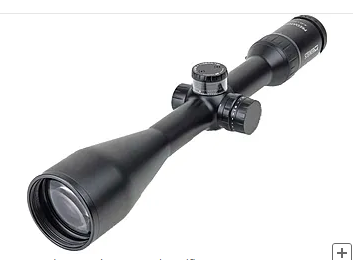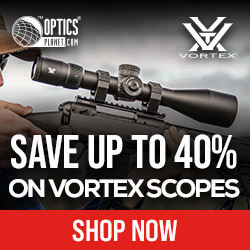As a hunter, you may want to know the functions and the difference in some of the gun optics available on the market. Here are some of the main functions and features that you should look for when choosing a gun optic:
– Magnification: This is the ability of the optic to enlarge the image of your target. Magnification is usually expressed as a range, such as 4-12x, which means you can adjust the magnification from 4 times to 12 times. The higher the magnification, the more detail you can see, but also the narrower your field of view and the more sensitive to movement. You should choose a magnification that suits your hunting distance and preference. For example, if you hunt at close to medium ranges, you may want a low to medium magnification, such as 1-6x or 2-10x. If you hunt at long ranges, you may want a high magnification, such as 6-24x or 8-32x.
– Objective lens size: This is the diameter of the front lens of the optic, measured in millimeters. Objective lens size affects the amount of light that enters the optic and the brightness of the image. The larger the objective lens, the more light and brighter the image, but also the heavier and bulkier the optic. You should choose an objective lens size that matches your hunting environment and light conditions. For example, if you hunt in low light situations, such as dawn or dusk, you may want a large objective lens, such as 50mm or 56mm. If you hunt in bright daylight, you may want a smaller objective lens, such as 40mm or 44mm.
– Reticle type: This is the pattern or shape that you see in the center of the optic when you aim at your target. Reticle type helps you align your gun with your target and estimate range and bullet drop. There are many types of reticles, such as crosshair, duplex, mil-dot, BDC, MOA, etc. You should choose a reticle type that fits your shooting style and preference. For example, if you want a simple and fast reticle, you may want a crosshair or a duplex reticle. If you want a more precise and advanced reticle, you may want a mil-dot or a BDC reticle.
– Turret design: This is the mechanism that allows you to adjust the windage and elevation of your optic. Turret design affects how easy and accurate you can dial in your shots and compensate for bullet drop and drift. There are two main types of turrets: capped and exposed. Capped turrets have covers that protect them from accidental adjustments and damage. Exposed turrets have no covers and allow you to quickly and easily adjust them on the fly. You should choose a turret design that suits your hunting scenario and preference. For example, if you hunt in rough terrain or conditions, you may want a capped turret to prevent unwanted changes or damage. If you hunt at varying distances or conditions, you may want an exposed turret to make quick and precise adjustments.
– Illumination: This is the feature that allows you to adjust the brightness or color of your reticle. Illumination enhances the visibility and contrast of your reticle in different light situations. Some optics have an illuminated reticle that can be turned on or off, while others have a non-illuminated reticle that is always visible. Some optics also have different colors for their reticles, such as red, green, blue, etc. You should choose an illumination feature that matches your hunting environment and preference. For example, if you hunt in low light situations or against dark backgrounds, you may want an illuminated reticle with a bright color, such as red or green. If you hunt in bright daylight or against light backgrounds, you may want a non-illuminated reticle with a dark color, such as black or gray.
These are some of the main functions and features that differentiate gun optics for hunting. Of course, there are other factors to consider as well, such as weight, durability, price, etc.

Steiner Predator 8 4-32×56
Zeroing your gun sight
Zeroing your gun optic is the process of aligning your point of aim (what you see through the scope) with your point of impact (where the bullet hits the target) at a certain distance. This will allow you to shoot accurately and confidently with your gun and optic combination. There are different methods and steps to zero your gun optic, depending on the type of optic, the type of gun, and the distance you want to zero at. Here are some general guidelines to help you zero your gun optic:
– First, you need to mount your optic securely and correctly on your gun. You can use a good quality base mount and mounting rings to ensure that your optic is stable and level. You also need to position the eyepiece correctly so that you can see a clear and sharp image through the scope. You can use a small torpedo level to check for level and tighten the rings gradually. For more details on how to mount your optic, you can watch this video¹ or read this article.
– Second, you need to choose a distance to zero your optic at. This will depend on your preference, your hunting or shooting scenario, and the ballistic characteristics of your gun and ammunition. For example, if you are using a .308 rifle for hunting deer, you may want to zero your optic at 200 yards, which is a common hunting distance. If you are using a .223 rifle for target shooting, you may want to zero your optic at 100 yards, which is a standard range distance. You can also use a ballistic calculator to find the best zero distance for your setup.
– Third, you need to set up a target at the chosen distance and mount your gun in a rest or a bipod. This will help you eliminate any movement or error from your shooting position. You can use a bullseye target or a grid target that has measurements to help you make adjustments on your optic. You also need to make sure that the range is safe and clear before you start shooting.
– Fourth, you need to load your gun and take three to five shots at the center of the target. This will give you an idea of where your point of impact is relative to your point of aim. You can use a spotting scope or binoculars to see where your shots are hitting on the target. You can also mark your shots with a marker or a sticker to keep track of them.
– Fifth, you need to adjust your windage and elevation knobs on your optic according to where your shots are hitting on the target. Windage is the horizontal adjustment and elevation is the vertical adjustment. Each click on the knob will move your point of impact by a certain amount, depending on the magnification and specification of your optic. For example, if your optic has 1/4 MOA clicks, each click will move your point of impact by 1/4 inch at 100 yards, or by 1/2 inch at 200 yards. You can use this formula to calculate how many clicks you need to adjust: Number of clicks = (Distance from center / Click value) x (Zero distance / 100). For example, if your shots are hitting 2 inches left and 1 inch low at 200 yards, and your optic has 1/4 MOA clicks, you need to adjust: Number of clicks for windage = (2 / 0.25) x (200 / 100) = 16 clicks right Number of clicks for elevation = (1 / 0.25) x (200 / 100) = 8 clicks up
– Sixth, you need to repeat steps four and five until your point of impact matches your point of aim at the center of the target. This means that you have successfully zeroed your gun optic at the chosen distance. You can also verify your zero by shooting at different distances and making minor adjustments if needed.
These are some basic steps on how to zero your gun optic. There may be variations depending on the type and model of your optic, such as parallax adjustment, reticle type, turret design, etc. You can refer to the manual or website of your optic manufacturer for more specific instructions.
One of the most important aspects of hunting is having a good optic for your gun. A good optic can make the difference between a successful hunt and a missed opportunity, or even worse, a wounded animal. A good optic can help you see your target clearly, adjust for windage and elevation, and compensate for bullet drop and drift. A good optic can also enhance your shooting accuracy, confidence, and safety.
There are many factors to consider when choosing a good optic for your gun, such as magnification, objective lens size, reticle type, turret design, illumination, weight, durability, and price. Depending on your hunting style, preference, and budget, you may want to opt for different features and specifications. For example, if you hunt at long ranges, you may want a high magnification scope with a first focal plane reticle and a ballistic turret. If you hunt in low light conditions, you may want a large objective lens with an illuminated reticle. If you hunt in rugged terrain, you may want a lightweight and durable scope with a capped turret.
To help you find the best optic for your gun, we have reviewed some of the most popular models on the market in 2023. We have tested them for their optical quality, mechanical performance, ease of use, and value for money. We have also compared them with their competitors and highlighted their pros and cons. Here are our top picks for the best hunting optics of 2023:
– Best Overall: Vortex Razor HD LHT 4.5-22×50 FFP
– Best Budget: Burris Fullfield E1 4.5-14×42 best overall customer choice
– Best Premium: Schmidt & Bender Exos 3-21×50
– Best Customizable: Steiner Predator 8 4-32×56



